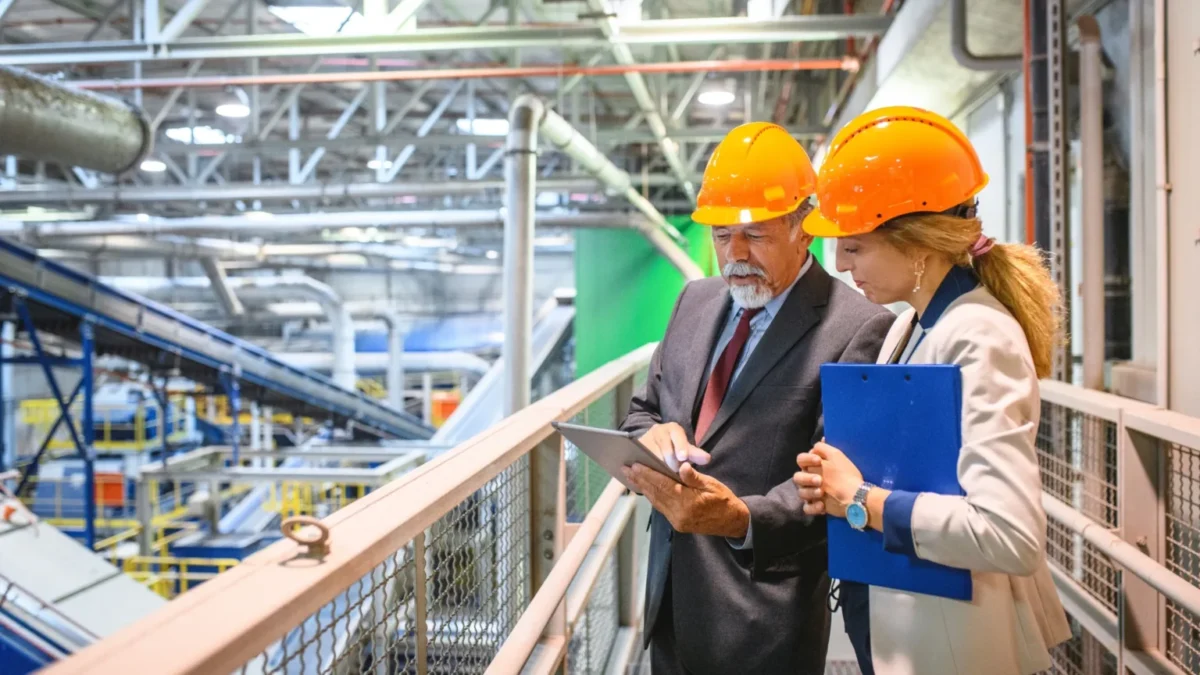
Facility maintenance supports facility safety by helping you make sure all building systems are operating correctly and safely. Facility managers can use maintenance to keep all safety equipment in good working condition, inspect and repair any potential safety hazards, and systematically check for safety hazards. Facility safety, though, means more than just preventing dangerous asset and equipment failures. Facility managers can also implement a visitor management solution to control building access and facilitate effective emergency evacuations.
What is facility safety?
Facility safety is how you keep everyone and everything in your facility safe. It requires a complete, interconnected combination of:
- Hardware
- Software
- Policies
- Procedures
Take fire suppression, for example. Just for hardware, you need:
- Sprinklers
- Hose reels
- Extinguishers
- Smoke detectors
- Sirens
- Fireproof doors
And those are only some of the basics. For software, you need one platform to help you map out where to put all the hardware and another to monitor everything once you’ve got it there. To get it all up and running, ensure you can trust it in an emergency, and be confident that everyone in the facility knows what to do when they hear those alarms, you also need a solid set of policies and procedures, including ways to test, train, and drill.
Fire suppression is synonymous with safety, so it makes an easy-to-understand example. But there are many other dangers facility and maintenance managers need to consider. Slips and falls are a major cause of accidents. Falling objects are, too. Unauthorized entries can have tragic consequences, so visitor management, controlling who can enter the building and where they can go once inside, plays a vital role in protecting employees.
Why is facility safety important?
On the most basic level, facility safety is important because life is precious. But the importance of safety goes beyond the well-being of your employees. A strong safety culture and program at your organization can improve asset uptime, boost employee productivity, and help you avoid costly fines and legal fees.
Organizations that implement and maintain safety programs enjoy:
- Fewer employee injuries
- Less asset and equipment downtime
- Lower operational costs
- More opportunities to attract and retain talent
A bit more on that last item: People want to work in safe environments. From the production floor to the front office, if someone coming in for an interview sees the facility isn’t safe, they won’t likely want to work there. First impressions count.
What is the role of maintenance in facility safety?
Facility maintenance management can be a powerful tool in helping keep your facility safe. In fact, staying on top of maintenance can help you reduce many of the most common injuries and issues. When everything is up and running smoothly, there are fewer chances of accidents.
According to the 2022 Workplace Safety Index from Liberty Mutual Insurance, the ten most common workplace injuries are:
- Overexertion handling objects
- Falls on the same level
- Struck by object or equipment
- Falls to lower levels
- Other exertions from awkward postures
- Roadway incidents involving land vehicles
- Slip or trip without fall
- Caught in or compressed by equipment
- Struck against equipment
- Non-roadway incidents involving land vehicles
You can prevent falls to lower levels, for example, by ensuring safety and hand railings are installed and secure, and stairs are straight and even. By checking the supports on your overhead electrical and HVAC, you can prevent injuries from falling objects. Keeping equipment running smoothly means operators are not tempted to reach inside to clear jams, risking getting caught or compressed. Replacing defective or burned-out lighting ensures drivers can see around their vehicles, reducing the chances of non-roadway incidents.
For instance, for forklifts in a warehouse, a preventive maintenance program that includes regular inspections and tasks for the brakes also improves safety. Something as simple as periodically checking that the forklift horns work could mean the difference between a close call and a serious accident.
Here are more ways to leverage your maintenance program to support safety in the workplace.
Think of preventive maintenance as “potential disaster avoidance”
Sometimes, an asset or piece of equipment just quietly goes offline when it fails. The fan in the air conditioning unit simply stops spinning. But some failures are much more dangerous. Once the gas pressure is off in an older furnace, for example, it can explode or catch fire.
Depending on the asset or equipment, a failure could lead to:
- Chemical spills
- Electrical fires
- Flooding
- Noxious fumes
- Sewage release
And it doesn’t have to be something you’re actively using. Improperly stored lithium-ion batteries pose a significant fire hazard. If you store them together, you risk a chain reaction where a single battery’s thermal runaway causes the other batteries to catch fire.
With a robust preventive or predictive maintenance management program backed by a modern enterprise management (EAM) solution, you can find and fix small issues before they become dangerous. Once you’ve set up and scheduled the right combinations of inspections and tasks in the software, you don’t have to worry about missing problems before it’s too late.
Control who can come into the facility with visitor management So much of facility safety is making sure you’re looking after your assets and equipment. But in today’s world, sometimes people are the problem.
With visitor management systems (VMS), visitors can register remotely. After answering a few key questions, they receive custom QR codes that let them check in when they arrive. It’s a convenient feature for visitors but also powerful protection for you. The software helps you increase workplace security by:
- Maintaining integrated watch lists
- Matching identification
- Pre-approving visitors
That’s for controlling who can come into the facility. But what about when you need to get everybody out in an emergency? Fire, flood, earthquake, or even an active shooter — these events require a clear evacuation plan. With the emergency list feature, any admin in the system can send an emergency evacuation alert, notifying not only security teams but also all the people in the building. You can then monitor the evacuation efforts in real-time. And as soon as the first responders arrive, you can provide them with an accurate, up-to-date list with a centralized view of who’s on site.
Facility safety is a habit
On top of the right hardware, software, policies, and procedures, you also need the right mindset. Safety has to become a habit. And not only for the facility and maintenance manager. Everyone must invest the necessary time and focus to learn the safety plans so that if disaster does strike, everyone knows what to do and how to stay safe.




